From birdwatching, to hunting, to hiking, to simply taking in natural scenery, wildlife viewing is one of the most popular functions for binoculars. Wildlife viewing binoculars should be powerful enough to allow you to get a great view of the subject without coming too close or startling it. They should have large enough objective lenses to allow you to see clearly even in dim conditions. Furthermore, they should be sturdy and portable enough to accompany you on all of your outdoor adventures. For these purposes, 8X42 is probably the sweet spot where all of your criteria are most likely to be met. In this article, we’ve selected for review some of our favorite 8X42 binoculars which are well-suited for a variety of wildlife viewing applications.
We Recommend
Best Binoculars for Wildlife Viewing
1. Nikon Monarch5 8X42 Wildlife Binoculars
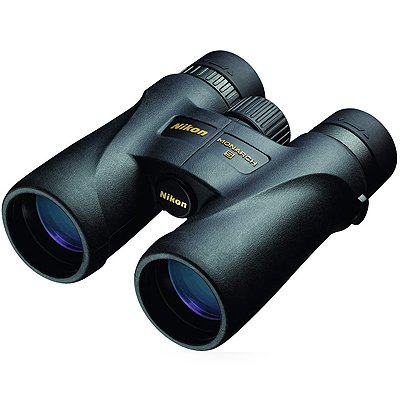
The Nikon Monarch 5 is a popular set of versatile binoculars form a manufacturer that is trusted and beloved for its high quality optics. Nikon specializes in camera equipment but is known for producing a range of precision optics equipment at prices that are generally very affordable when compared to competitors with similar pedigrees.
Monarch 5 handles low-light conditions surprisingly well and offers a premium viewing experience featuring crystal clear images and vibrant saturated colors.
Waterproof, fog-proof, and a rubber-armored, the build quality of the Monarch 5 is top notch. These durable binoculars are built to handle rigorous outdoor conditions. Built with Nikon’s legendary glass lenses, the Monarch 5 offers excellent range while maintaining superior contrast thanks to multilayer coatings, which provide higher light transmission across the spectrum.
With 8x magnification and 42 millimeter objective lenses, the Monarch 5 strikes a nice balance between power and portability. Easily fitting into a backpack, these binoculars are both trail-ready and powerful.
What we liked
- Small size and sleek design offer extreme portability
- Comfortable eyepoint design with adjustable eyecups
- Durable rubber-armored body to withstand extreme use
- Simple and intuitive central focus knob
- Multilayer coatings allow for greater light transmission
- High eyepoint design provides clearer field of view and sufficient space for eyeglasses
- O-ring sealed for waterproof and fog-proof performance
What we didn’t like
- Fine tuning may be hard to adjust
Aperture: 42 mm
Magnification: 8x
Lens diameter: 42mm
Field of view: 6.3°, 300 feet @ 1000 yards
Eye relief: 19.5mm
Weatherproof: Waterproof
Weight: 1.3lb
2. Vortex Optics Viper HD Roof Prism Binoculars
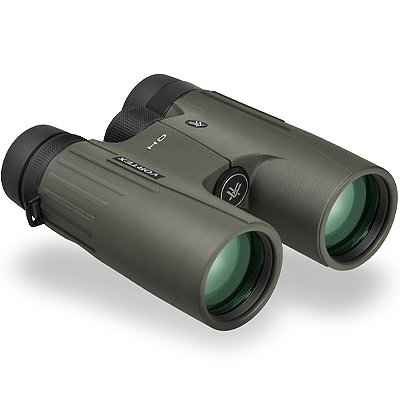
The Viper HD is a set of binoculars which features on quite a few of our optics lists. Vortex Optics is a fantastic company which produces products of which they are evidently proud. Most Vortex products, including the Viper HD, are backed by an expansive “VIP” warranty. The Viper HD is obviously supported by this warranty on account of Vortex’s confidence in its build quality.
Perfect for hunters, shooters, and outdoor enthusiasts, these binoculars offer a stunning resolution, excellent color fidelity, and edge-to-edge clarity at a price range that is reasonable and reflects their value. The Viper HD is built to last you a lifetime of outdoor exploration.
Don’t let these delicate high-definition optics fool you, the Viper HD is ruggedly designed and features extreme durability for reliable performance in all types of environments. Rubberized barrels, a sturdy focus knob, and adjustable and locking eyepieces add to the viewing experience. These binoculars are easy and intuitive to operate and are an ideal companion for a wide range of outdoor settings.
What we liked
- Smooth magnification and crisp image resolution
- Clear edge to edge image transmission
- Superior customer service and warranty
- GlassPak chest harness included for comfortable all-day carry
- Other accessories include a rain guard, carrying case, and strap
- Waterproof, fog proof, and lightweight design
- Bring in lots of light making them suitable in many conditions
What we didn’t like
- Eye relief lacks adjustability
- Close focus is 6.5-7 feet
Aperture: 42 mm
Magnification: 8x
Lens diameter: 42mm
Field of view: 6.6°, 347 @ 1000 yards
Eye relief: 20mm
Weatherproof: Waterproof
Weight: 1.5lbs
3. Celestron Nature DX 8X42 Wildlife Binocular
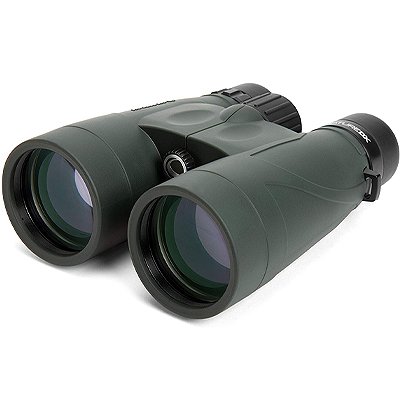
The Celestron Nature DX is a perfect entrypoint into high-end optics for beginners looking for a trustworthy trail companion. These binoculars are an excellent combination of premium build, portability, and price.
Affordable and a favorite among both birders and outdoor enthusiasts, these binoculars offer a mid-size solution at an entry price point. Everyone from beginners to the outdoors enthusiasts will enjoy this top-rated pair of binoculars thanks to their robust build and impressive specs.
The large objective lens and powerful magnification provide detailed views of distant subjects, even in low light conditions. Designed with comfort in mind, adjustable eyecups make them easy to use with or without glasses.
Premium prism glass and fully coated lenses, along with comfort and durability, make this a great pair of binoculars for wildlife viewing. Specifically designed to endure your travels without fogging up, they even offer premium waterproof protection at a beginner’s price.
What we liked
- Entry level price point for beginners
- Phase-coated BaK -4 prisms for top-rated optics
- 8x magnification power and 6.5-foot close focus
- Mid-sized body giving great optics without the bulk
- Robust, waterproof housing for increased durability
- Includes carrying case and other necessary accessories
- Popular brand backed by warranty and customer support
What we didn’t like
- Difficult to adjust for larger users
- Size limits length of use. Definitely quite heavy compared with similar-sized models
- Limited waterproof capabilities
Aperture: 56 mm
Magnification: 8x
Lens diameter: 42mm
Field of view: 5.5°, 289 feet @ 1000 yards
Eye relief: 16mm
Weatherproof: Waterproof
Weight: 2.5lbs
4. Olympus 8X42 PRO Wildlife Binocular
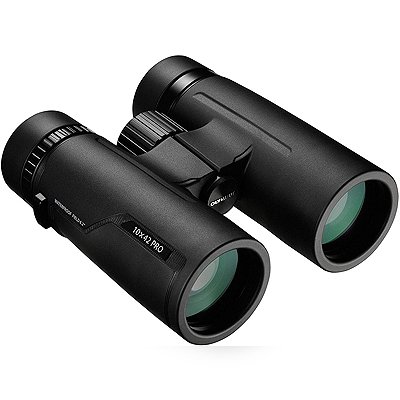
The Olympus Pro is designed with professionals in mind. Serious outdoor enthusiasts won’t be able to keep their hands off of these rugged and durable binoculars.
A heavy-duty rubberized coating offers a non-slip grip and rugged protection while their weather-sealed design means they can withstand more than a little water. For wet or rough trail conditions, the Olympus Pro is a total catch.
The Olympus Pro can endure being submerged in up to 3 feet of water for up to 5 minutes before they will start to be susceptible to damage. With excellent low-light performance and bright and vibrant colors, the Olympus Pro is an excellent choice for any birder.
Quality innovations like ED lenses and phase correcting multi-coating technology (including Olympus’ acclaimed ZERO coatings for high contrast) result in an extremely satisfying high resolution viewing experience.
What we liked
- Oil repellent coatings for easy removal of dirt and water drops
- Built-in dioptric correction
- Long eye relief and adjustable eyepieces
- ED lens for chromatic aberration compensation
- Flip down objective lens cap to prevent loss
- Suitable for multiple uses including bird watching, hiking, watersports, and nature
- Exceptional 1.5m close focusing distance allows user to see fine details even at close range
What we didn’t like
- Focusing wheel may need a lot of turning
- Potential sharpness loss on edges of field of view
Aperture: 42 mm
Magnification: 8x
Lens diameter: 42mm
Field of view: 6.2°, 525 feet @ 1000 yards
Eye relief: 16mm
Weatherproof: Waterproof
Weight: 1.5 lbs
5. Celestron 71402 TrailSeeker 8X42 Binoculars
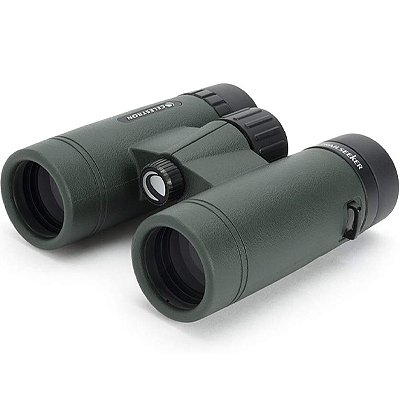
Premium quality binoculars at an affordable price are the hallmarks of the Celestron brand. This reputation is reflected by the Celestron Trailseeker. These 10X42 binoculars offer stellar views in a beginner-friendly and durable package.
Superior optics and coatings allow for increased light transmission creating sharper and brighter images. Enhanced contrast and resolution provide unrivaled image detail to enhance your wildlife viewing. Their durable and lightweight body make them perfect for hiking, birding, or any other activity wherein portability is a major factor.
Rugged magnesium alloy frames allow for a sleek design that’s light in weight with the added feature of being waterproof. With fit and function in mind, these ergonomically designed binoculars have ease of use that make them perfect for birdwatching adventures.
Unique multi-stop twist-up eyecups provide comfort and accommodation with or without glasses. More durable than plastic eyecups, this pair boasts metal eyecups that offer a longer lifespan as well as correct positioning. Their wide field of view makes them ideal for following moving subjects without needing to move your binoculars. Accessories come included with this great all-around pair of wildlife viewing binoculars.
What we liked
- Great price
- Durable in any weather
- Lightweight magnesium alloy frame
- Multi stop for correct eye positioning
- BaK -4 prisms provide brighter and sharper images
- Phase and dielectric coatings allow for increased light transmission
- Popular brand backed by warranty and customer service
What we didn’t like
- Wide field of view may distort edge vision
- Compact design may not be best for larger hands
Aperture: 42 mm
Magnification: 8x
Lens diameter: 32mm
Field of view: 6.2°, 525 feet @ 1000 yards
Eye relief: 14.4mm
Weatherproof: Waterproof
Weight: 1lb
Porro-prism vs. roof-prism binoculars
When looking for the best binoculars for wildlife viewing, you’re likely to come across words like Porro-prism and roof-prism. Simply put, these are the differences in how light passes into and out of the internal prisms of the binoculars.
Porro-prism binoculars
Porro-prism binoculars, although less popular, can be an excellent choice for certain applications. Still a favorite among bird watchers and hunters alike, Porro-prism binoculars have long been a staple for wildlife viewing, especially in dim lighting conditions.
However, since their introduction, roof-prism binoculars have become more popular, especially among hunters, given their sleek design and lightweight construction. Consider these points for your viewing needs to determine which type will work best for you.
Roof-prism binoculars
Roof prism binoculars are more compact due to how closely their internal prisms overlap, allowing a sleek design that lines up with the eyepiece. They tend to be more popular for this reason. But while small, their internal construction is more intricate, leading to higher costs.
In contrast, Porro-prism binoculars have a zig-zag design that offsets the eyepiece from the objective lens. While this allows a clearer image with better depth perception, due to the increase in light reaching the internal lenses, these binoculars tend to be bigger, bulkier, and more prone to damage from impacts due to this design feature.
What do the binocular numbers mean?
When choosing the best binoculars for wildlife viewing, you will see numbers such as 10×32 or 8 x42. These numbers refer to the magnification power of the binoculars and the size of the diameter of their objective lenses, usually in millimeters.
- A pair of 8×32 binoculars would have eight times the magnification power of your naked eye and an object would appear to the viewer. An object 800 feet away would appear as though it were 100 feet away.
- Their objective lens diameter would be 32 millimeters in diameter. The objective lens is the front lens, usually the largest part of the optic.
- The larger the objective lens, the more light that enters the binoculars and therefore, the sharper or brighter the image will be. Although larger objectives usually mean brighter, sharper, and clearer images, they come with a tradeoff.
- Larger objectives add bulk and weight to binoculars and users should consider how they will hold, pack, and carry their set when choosing a pair.
Which is better 8X42 or 10X42 binoculars?
Now that you know what those numbers mean, how do you decide based on the popular options out there? Do you need 8×42, or would something like 10×42 work better for your purposes? One thing to remember is that more power is not always better.
Hunters and birders naturally gravitate towards the 10x binoculars simply for the greater magnification, but 8x binoculars have their benefits as well. Both options offer high power, but the difference is in the subtle details. While 8x are often cheaper than 10x units, they can be less powerful for details and identification, possibly making them less practical.
And while a 10x pair offers better image quality, they have a narrower field of view which can make tracking moving objects more difficult. See below for a list of considerations when choosing a pair for the following activities:
- Backpacking and hiking – lightweight is key when you’re on the move so consider lightweight and compact pairs to the tune of 8×42.
- Birding – birding naturally lends itself to higher magnifications, so consider 10×42 binoculars as you’ll most likely be observing from greater distances.
- Hunting – Anything in the 7x to 10x range is suitable for hunting and personal selection varies greatly based on what type of hunting you are doing.
- Whale watching, wildlife viewing, and safaris – You’ll need maximum reach to keep a safe distance when doing any of these activities. 10×42 is best for long-range wildlife spotting.
- Stargazing – You’ll need maximum power to make it worth your effort in this area. Opt for at least 10x magnification or higher if possible. But remember, anything higher than 10x is best supported by a tripod to keep them steady and give you the best view.
The wildlife binoculars price timeline
Binoculars can be a lifelong investment if you do your research carefully. Price depends largely on the quality of the optics, lens coatings, and other features such as ruggedness or housing material, not to mention which prism system they employ. Depending on the budget and primary purpose of your binoculars, you’re sure to find something suitable in the following ranges:
Budget (0-150$) – You don’t have to break the bank to get into the game. Sets at this price point will deliver good (sometimes great) fields of view at a budget price. Their optical quality may leave a bit to be desired, though.
Value (150-300$) – Binoculars in this group will feature brighter images, more accurate color, and better resolution. This is a great range for beginners looking for serious equipment.
Lower Mid-Range (300-500$) – Featuring a step up in glass quality, this level of binoculars offers brighter images and more accurate hues due to higher quality. Enthusiasts will begin finding worthwhile investments in this range.
Upper Mid-Range (500-1000$) – Offering exceptional value for optics, binoculars in this range let you step up without completely breaking the bank. They feature higher quality components and glass enhancing image quality.
High End (1000-2000$) – Premium lens coatings and high-density glass deliver clear images with bright colors and contrast in this range. Many models also come with specific functionalities like digital zoom and image stabilization.
First Class (2000$ +) – Exceptional performance in a variety of conditions, coupled with top notch materials and construction are hallmarks of this elite category. Binoculars in this price range offer unrivaled wildlife viewing experiences. This range is suitable for professionals and enthusiasts.
How to choose the right binoculars for wildlife viewing?
When choosing the right binoculars for wildlife viewing, there are a few key things that help to bring clarity to your decision. You’ll want to consider the following points when evaluating optical performance, as well as keeping in mind your own personal considerations.
Aperture
Measured in millimeters, this is the width of the front or objective lens. Larger lenses bring in more light, making objects especially visible in dim lighting conditions.
Field of view
This specification states the width of the area you will be able to view at a glance. Having a narrower field of view, like in higher magnifications, can make it harder to locate small or moving objects.
Lens coating
Coatings on the glass can reduce reflection and help determine the clarity and brightness of the image.
Eye relief
Key for glasses wearers, this is the distance between an eyepiece and your eye while the field of view is visible. Most binoculars allow for some adjustments to the eyepiece through a variety of mechanisms. Look for eye relief of 15mm or more if you wear glasses.
Weatherproofing
This feature largely depends on the type of activities you will use your binoculars for. Manufacturers differ in how they describe levels of water resistance. Waterproof binoculars typically employ O-rings to block moisture, while weather-resistant models offer protection against lighter rain situations.
Weight
Consider how and where you will need to carry your binoculars for wildlife viewing when making your selection. Additionally, the weight of your set can impact the length of your viewing session if you’re not using a tripod. For wildlife viewing on the go, you may want to look into more compact binoculars.
Related: 5 Best Binocular Harnesses in 2022 (Low-Profile & Full-Size)
